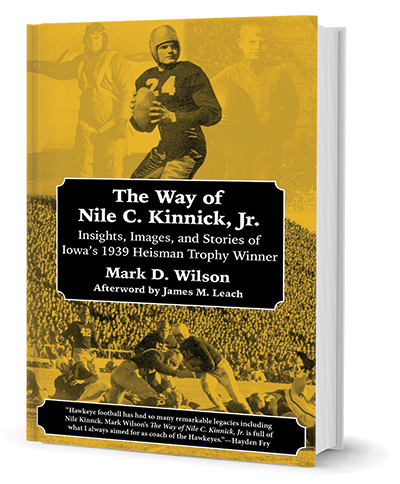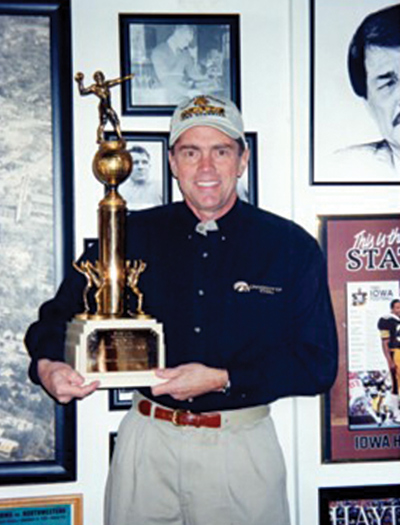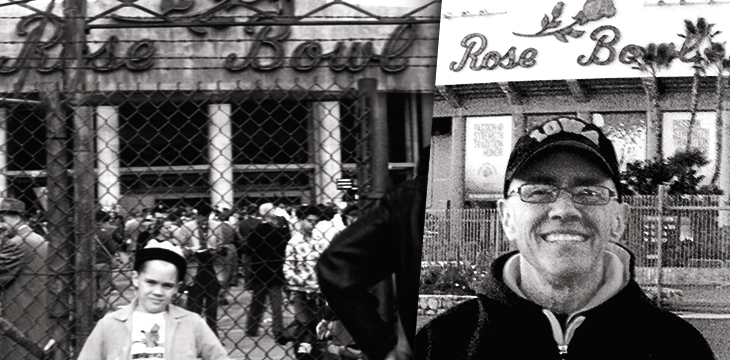Piecing Together Hawkeye History
Editor’s note: Mark Wilson (69BA, 78MA) is a volunteer ambassador at the UI Athletics Hall of Fame. This essay is excerpted from his forthcoming book, The Way of Nile C. Kinnick, Jr., which will be released Sept. 1 by Ice Cube Press and its publisher, Steve Semken (87BA). The book will be sold online and around Iowa, including locally at the Iowa Hawk Shop, Iowa Book, the Black and Gold Shop, Prairie Lights, and Barnes and Noble.

In 2003, Joshua Larsen, a graduate assistant for the athletic department, delivered a cardboard box of vintage trophies to the recently opened hall of fame and museum for display or storage. While I was sitting at the greeters’ table, Larsen asked me what needed to be done with the old trophies. I said I would take the trophies to the basement for safekeeping. When Josh left, I looked in the box to see what the items were. Many were small, but probably significant trophies that were won by student-athletes decades ago. There were also loose trophy parts and pieces that were broken from some of the trophies’ bases.
A few of the loose trophy parts, in particular, caught my attention. They were statuettes. After examining them more closely, I discovered that the pieces were part of a “puzzle” necessary to reconstruct, what turned out to be, Nile Kinnick’s 1940 Walter Camp Trophy, awarded to the nation’s best college football player. What amazed me was that all of the pieces to the trophy were still in the box. None of the broken statuettes were missing after 63 years when Kinnick had received the award in 1940! I suspect the trophy had been set aside for repairs sometime in the past and then lost in the shuffle moving it from place to place for safekeeping.
The brass nameplate was discolored and hard to read, but I was able to determine what some of the letters were and realized that this was one of Nile Kinnick’s trophies. The four “punting pose” statuettes that were previously mounted on the base of the trophy and the “quarterback throwing pose” at the very top of the trophy were horizontally broken at the ankles. There was an attempt to place a small steel rod in the ankle and upper leg of one of the statuettes, but the rod did not secure the two parts of the statuette.
 Photo: Ice Cube Press
Top Image: Nile Kinnick holds the Walter Camp Memorial Trophy following his legendary 1939 senior season. Above: Mark Wilson displays Kinnick's Walter Camp Memorial Trophy after painstakingly repairing it in 2003. The trophy today is on display at the UI Athletics Hall of Fame.
Photo: Ice Cube Press
Top Image: Nile Kinnick holds the Walter Camp Memorial Trophy following his legendary 1939 senior season. Above: Mark Wilson displays Kinnick's Walter Camp Memorial Trophy after painstakingly repairing it in 2003. The trophy today is on display at the UI Athletics Hall of Fame.
I was told that replacing the statuettes would diminish the value and authenticity of the trophy. Also, the trophy shop’s estimate for repair was very expensive. Liking a challenge, I offered to take this project on myself and attempt to restore this piece of memorabilia to its original condition. My goal was to have the trophy placed in the display case next to Kinnick’s Heisman Trophy in the UI Athletics Hall of Fame and Museum, filling in more of the history of Nile.
It goes without saying that I had no experience taking on such a delicate and time-consuming project, but I felt that, if I didn’t, there was a possibility that this piece of Hawkeye history might never be shared. Something had to be done, so with permission, I gathered up the broken trophy pieces and transported them to my house. I felt a bit elated. As a Hawkeye sports fan, having the Walter Camp Trophy in my car seemed a bit unreal.
I spent the first few weeks of this three-month project contemplating what materials, tools, and procedures I would use for each step of the process. When I decided to use the family room as my workshop, my wife wasn’t too thrilled at first, but she knew how important this project was to me and finally agreed.
After planning my steps and procedures, I was ready to begin. I decided to use a suitable adhesive to bond the upper and lower pieces of each of the five statuettes. It was a tricky, tedious, and time-consuming process since each of the statuettes were broken horizontally at the ankles. It was similar to someone taking a sharp knife and making a clean cut through each of the ankles. The welding agent took a minimum of 15 hours to adhere properly, and many times the leg of the statuette would gradually slide a fraction of an inch. I would have to constantly observe for slippage, and when it did, I would start over again trying to adjust and fixate the upper and lower portions of the statuette.
 Photo: Ice Cube Press
At left, 10-year-old Mark Wilson at his first football game—the 1957 Rose Bowl between Iowa and Oregon State. At right, Wilson at the Rose Bowl again in 2016 when Iowa played Stanford.
Photo: Ice Cube Press
At left, 10-year-old Mark Wilson at his first football game—the 1957 Rose Bowl between Iowa and Oregon State. At right, Wilson at the Rose Bowl again in 2016 when Iowa played Stanford.
My goal was to have no noticeable errors by the completion of the welding process and be sure the ankles were perfectly matched. To accomplish this and obtain balance, I experimented by sitting in a corner of our house with my back reinforced by the walls. I held the two pieces of the statuette firmly together waiting for the bonding agent to set. Unfortunately, when I would barely move, the upper and lower parts of the leg would separate. It took me awhile, but I realized this method would not work. I finally ended up using a small vise, bookends, and knickknacks from our family room—such as magazines, notepads, books, and a screwdriver—to secure and balance each statuette to complete the drying stage.
Once the statuette was dry and secure, I began the buffing and shaping stage using a rotary hand tool to remove the excess welding agent around the ankle area. This was a very delicate process requiring a gentle touch with minimal amounts of pressure. Once this step was completed, the antiquing process began. I used my fingers to rub in a gold leaf finish on each statuette to avoid the look of brushstrokes.
When the project was finally completed, the trophy, in my opinion, looked just like the original in the 1940 photograph I have of Nile holding his Walter Camp Trophy.
I did have one additional setback before transporting the trophy back to the UI Athletics Hall of Fame and Museum. After placing it carefully in the front seat of my vehicle, I secured the Camp Trophy by leaning it slightly back against the front passenger seat so it would not move or tip over in transport. Due to the weight of this 26-inch trophy and the angle of the trophy, one of the statuettes came apart where I had welded the legs together. My heart sank. What was I going to do? After three months of painstaking work, really it was a labor of love, I took the trophy back home and began the process all over again for the one statuette. I removed it from the base, cleaned off the existing weld, reapplied the new bonding agent, secured the statuette in a vise using odds and ends from the family room, buffed off the excess weld, and after 36 hours, applied the antiquing solution. This time I had signs all over the house urging my family and friends not to slam any doors and to walk gently throughout the house. I didn’t want to jar any of the five statuettes, risk another breakage, and have to start all over again.
The day finally arrived for transporting the Walter Camp Memorial Trophy to its new home, the University of Iowa Athletics Hall of Fame. This time I called Dale Arens, director of the hall of fame and museum, to assist me. When he arrived, I sat in the front passenger seat holding the trophy firmly in my lap. We thought about a police escort since this was truly a unique part of Hawkeye history, but we realized maybe that was going a little too far.
